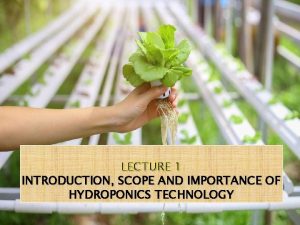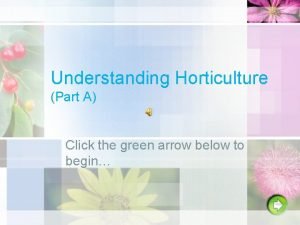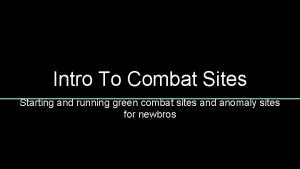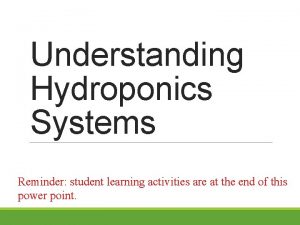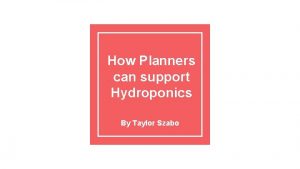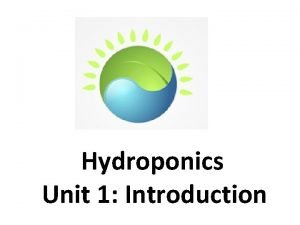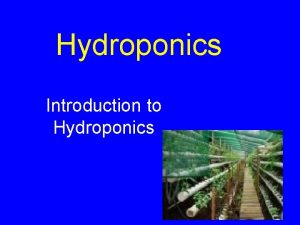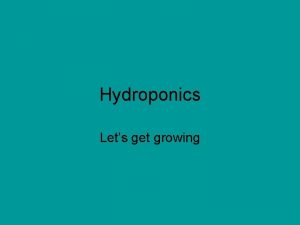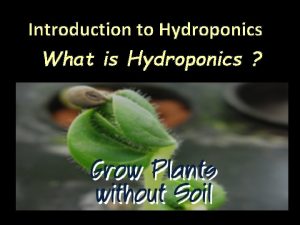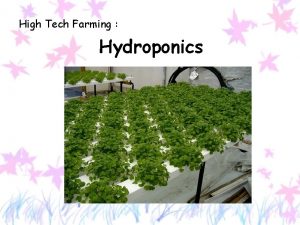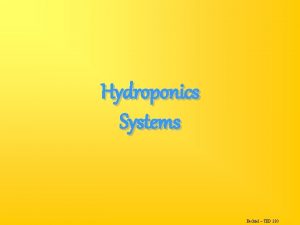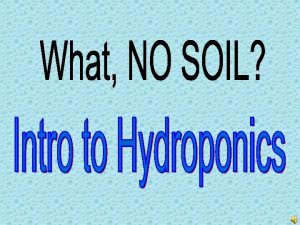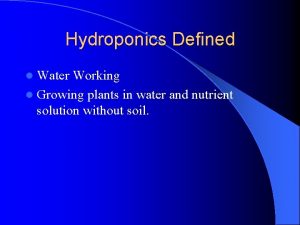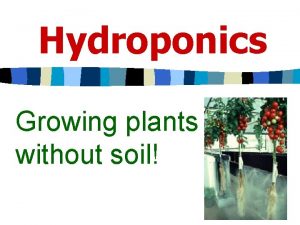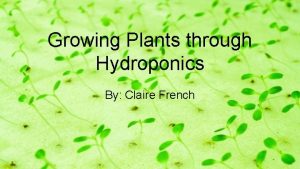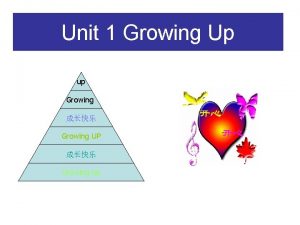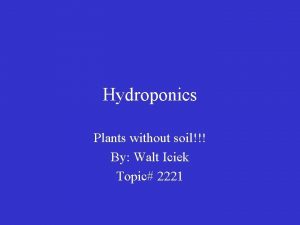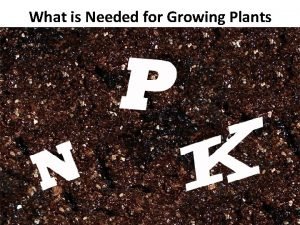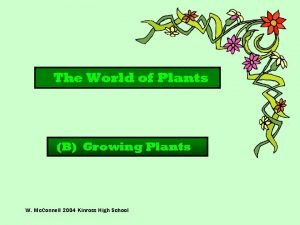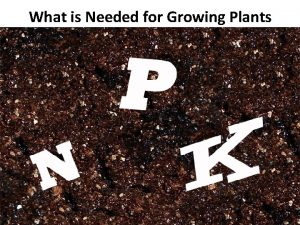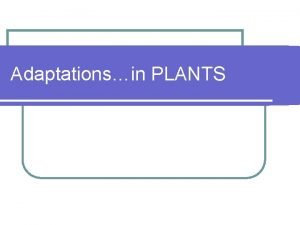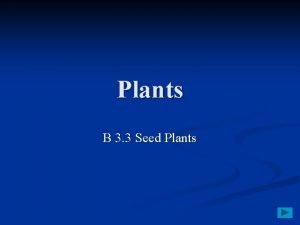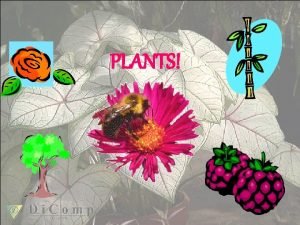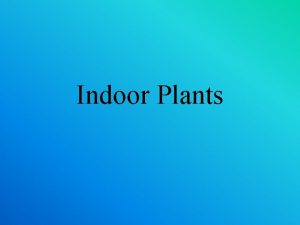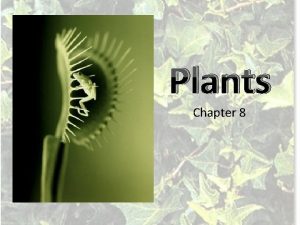Hydroponics Hydroponics The growing of plants in a







































- Slides: 39

ÓHydroponics

ÓHydroponics ÓThe growing of plants in a solution of nutrients necessary for plant growth, rather than directly in soil.

ÓSubstrate Óthe substance in which something takes root

ÓGeneral Facts: Óany plant can be grown in a hydroponics system Óalmost any system will produce acceptable growth

ÓGeneral Facts; Ósmall scale is entirely different from the culture of several thousand plants Óhas contributed much to understanding plant growth

ÓGeneral Facts: ÓVery few commercial producers ÓMost facilities are experimental, studying plant nutrition

ÓDifferent Names: Ónutriculture Ósolution culture Óslop culture Ógravel culture

ÓRequirements for home hydroponics Óbest possible light Óhumidity 50% or more Óday temp 75 degrees Ónight temp 65 degrees

ÓRequirements for home hydroponics Óno need for special drainage system Ósmall scale, outstanding plants such as tomatoes, radishes, lettuce, carnations, roses, cabbage etc. produced

ÓRequirements for home hydroponics Óreturn is not sufficient for a hobbyist to earn a living.

ÓFacts about hydroponic growing Óplants don’t do well unless all essential nutrients are available in reasonable amounts

ÓFacts about hydroponic growing Ó 25 gallon container, minimum size for proper proportion of nutrients

ÓFacts about hydroponic growing Óthe larger the particles in the substrate, the more often it must be watered.

ÓCommercial use Óvery familiar with plants Óobservation can determine temps and nutrient deficiency

ÓCommercial use Óto earn a reasonable living you must grow thousands of plants

ÓCommercial use Óminimum of 100, 000 square feet is needed to break even financially

Growers must know about plants Ómost plants are very adaptive Óplants can take a lot of abuse

Growers must know about plants Óplants require a minimum amount of water, food, vitamins, sleep and proper temps.

Growers must know about plants Óeach species has its own requirements for maximum growth

Media Óalmost any inert material may be used as a substrate Ósubstrate must not decompose or be too fine

Media ÓRiver washed gravel is competitive in price with soil mixtures Óaeration of roots is necessary

Various Media Types Órock Óvolcanic ash Óvermiculite - heated mica Óperlite - exploded volcanic rock 1800 degrees F.

Various Media Types Ópeat moss Ógranite or sand Óidealite - concrete aggregate Ówater

Watering Ófrequency depends upon media Óeach time a hydroponics system is replanted, roots will be left, this increases water holding capacity

Conventional Irrigation Óflooding Óflood tray until water appears at surface Óperforated tube is used to fill and drain media as needed

Flooding Ónutrient solution is pumped back and tray is flooded again

Disadv. Of Flooding Ónutrient solution can become unbalanced Óbacteria and disease can be spread

Peripheral Gates Ónutrient solution applied and allowed to drain away Ónon recirculating system Óno storage tank

Peripheral Gates Óbacteria and diseases are drained away Ósolution is sprayed on

Disadv. Of Peripheral Ómore expensive, solution is not reused Óspraying can cause spread of disease by splashing

Ooze Tube System Ódrip holes in double tube Óno splashes ÓDisadvantages: most expensive

Facts about nutrients Óall plants require certain basic elements Óif nutrients are missing poor growth may result

Facts about nutrients Óplants need more of the major elements Óany deficiency is rapidly apparent

Facts about nutrients Ótrace minerals are often present in tap water in sufficient amounts.

Major Elements in a basic solution ÓCa - Calcium ÓK - Potassium ÓN - Nitrogen ÓP - Phosphorous ÓMg - Magnesium

Minor Elements ÓMn - Manganese ÓS - Sulfur ÓCu - Copper ÓB - boron

Minor Elements ÓFe - Iron ÓZn - Zinc ÓMo - Molybdenum

Recommendations ÓIf less than 25 gallons of nutrient solution is needed, purchase a commercial preparation ÓGet a scale that can weigh to less than 0. 01 oz.

Diatomaceous Earth ÓSkeletons of diatoms Ódried and used as a filter
 Importance of hydroponics
Importance of hydroponics What is horticulture
What is horticulture Serpentis phi outpost
Serpentis phi outpost Space engineers hydroponics
Space engineers hydroponics Understanding hydroponics
Understanding hydroponics Taylor szabo
Taylor szabo Aggregate culture hydroponics
Aggregate culture hydroponics Nonvascular plants
Nonvascular plants Non vascular plants
Non vascular plants Features of non flowering plants
Features of non flowering plants Photosynthesis equation
Photosynthesis equation Công của trọng lực
Công của trọng lực Tỉ lệ cơ thể trẻ em
Tỉ lệ cơ thể trẻ em Thế nào là mạng điện lắp đặt kiểu nổi
Thế nào là mạng điện lắp đặt kiểu nổi Lời thề hippocrates
Lời thề hippocrates Dot
Dot Vẽ hình chiếu đứng bằng cạnh của vật thể
Vẽ hình chiếu đứng bằng cạnh của vật thể Phản ứng thế ankan
Phản ứng thế ankan Các môn thể thao bắt đầu bằng tiếng bóng
Các môn thể thao bắt đầu bằng tiếng bóng Hình ảnh bộ gõ cơ thể búng tay
Hình ảnh bộ gõ cơ thể búng tay Khi nào hổ mẹ dạy hổ con săn mồi
Khi nào hổ mẹ dạy hổ con săn mồi điện thế nghỉ
điện thế nghỉ Thế nào là sự mỏi cơ
Thế nào là sự mỏi cơ Một số thể thơ truyền thống
Một số thể thơ truyền thống Trời xanh đây là của chúng ta thể thơ
Trời xanh đây là của chúng ta thể thơ Chó sói
Chó sói Thiếu nhi thế giới liên hoan
Thiếu nhi thế giới liên hoan Số nguyên là gì
Số nguyên là gì Vẽ hình chiếu vuông góc của vật thể sau
Vẽ hình chiếu vuông góc của vật thể sau Các châu lục và đại dương trên thế giới
Các châu lục và đại dương trên thế giới Thế nào là hệ số cao nhất
Thế nào là hệ số cao nhất Ng-html
Ng-html Hệ hô hấp
Hệ hô hấp Tư thế ngồi viết
Tư thế ngồi viết đặc điểm cơ thể của người tối cổ
đặc điểm cơ thể của người tối cổ Mật thư anh em như thể tay chân
Mật thư anh em như thể tay chân Tư thế worm breton
Tư thế worm breton ưu thế lai là gì
ưu thế lai là gì Tư thế ngồi viết
Tư thế ngồi viết Thẻ vin
Thẻ vin
